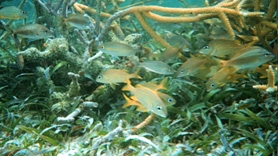- Habitat Home
- About Us
- Our Work
- About Habitat
- Funding Opportunities
- Our Partners
- News & Multimedia
- Publications & Resources
What is Essential Fish Habitat?
Fish require healthy surroundings to survive and reproduce. Essential fish habitat includes all types of aquatic habitat—wetlands, coral reefs, seagrasses, rivers—where fish spawn, breed, feed, or grow to maturity.
NOAA Fisheries works with the regional fishery management councils to identify the essential habitat for every life stage of each federally managed species using the best available scientific information. Essential fish habitat has been described for approximately 1,000 managed species to date.
NOAA and the councils also identified more than 100 “habitat areas of particular concern” or HAPCs. These are considered high priority areas for conservation, management, or research because they are rare, sensitive, stressed by development, or important to ecosystem function.
Impacts
Impacts from certain fishing practices as well as coastal and marine development threaten to alter, damage, or destroy these habitats. NOAA, the regional fishery management councils, and other federal agencies work together to minimize these threats. In addition, many projects conducted by NOAA’s Restoration Center focus on restoring essential fish habitat.
Productive commercial and recreational fisheries are inextricably linked to healthy marine habitats; protecting and restoring them will help support fishing communities now and for generations to come.


Useful Links
- Magnuson-Stevens Act
- EFH Regulatory Guidelines (pdf - 104kb)
- EFH and Critical Habitat Comparison (pdf - 5.1mb)
- EFH Mapper


